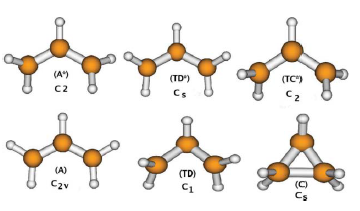Strongly correlated mechanisms of a photoexcited radical reaction from the anti-Hermitian contracted Schrödinger equation
Jonathan J. Foley IV, Adam E. Rothman, David A. Mazziotti
J. Chem. Phys.
2011

Photoexcited radical reactions are critical to processes in both nature and materials, and yet they can be challenging for electronic structure methods due to the presence of strong electron correlation. Reduced-density-matrix (RDM) methods, based on solving the anti-Hermitian contracted Schrödinger equation (ACSE) for the two-electron RDM (2-RDM), are examined for studying the strongly correlated mechanisms of these reactions with application to the electrocyclic interconversion of allyl and cyclopropyl radicals. We combine recent extensions of the ACSE to excited states [G. Gidofalvi and D. A. Mazziotti, Phys. Rev. A 80, 022507 (2009)] and arbitrary spin states [A. E. Rothman, J. J. Foley IV, and D. A. Mazziotti, Phys. Rev. A 80, 052508 (2009)]. The ACSE predicts that the ground-state ring closure of the allyl radical has a high 52.5 kcal/mol activation energy that is consistent with experimental data, while the closure of an excited allyl radical can occur by disrotatory and conrotatory pathways whose transition states are essentially barrierless. Comparisons are made with multireference second- and third-order perturbation theories and multireference configuration interaction. While predicted energy differences do not vary greatly between methods, the ACSE appears to improve these differences when they involve a strongly and a weakly correlated radical by capturing a greater share of single-reference correlation that increases the stability of the weakly correlated radicals. For example, the ACSE predicts a −39.6 kcal/mol conversion of the excited allyl radical to the ground-state cyclopropyl radical in comparison to the −32.6 to −37.3 kcal/mol conversions predicted by multireference methods. In addition, the ACSE reduces the computational scaling with the number of strongly correlated orbitals from exponential (traditional multireference methods) to quadratic. Computed ground- and excited-state 2-RDMs are nearly N-representable.